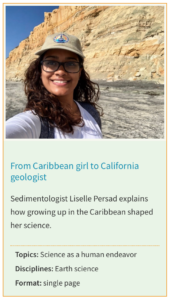 Science Stories are a rich resource for educators. They make key aspects of the nature and process of science explicit within the context of a particular scientific investigation or episode in the history of science. The examples in our database are drawn from different disciplines across science and come in different formats (from single paragraphs to multipage readers). Here are suggestions for incorporating these narratives into your teaching:
Science Stories are a rich resource for educators. They make key aspects of the nature and process of science explicit within the context of a particular scientific investigation or episode in the history of science. The examples in our database are drawn from different disciplines across science and come in different formats (from single paragraphs to multipage readers). Here are suggestions for incorporating these narratives into your teaching:
- Assign students to read or watch a Science Story as homework and report back (in a short essay question or presentation) what the story highlights about the nature and process of science. Ask students to reflect on whether and how their understanding of how science works changed through reading or watching the Science Story.
- Science Stories with a linear narrative arc (i.e., that tell the story of a particular scientific investigation in the order in which events happened) can be used with our How Science Works interactive or flowchart pdfs. Students can chart the journey of the researchers in the story to illustrate the iterative and dynamic nature of the process of science. Ask students to reflect on whether and how their understanding of how science works changed through this activity.
- Science Stories related to our Science Checklist can be used to help students understand the key traits that make science science. Ask students to evaluate each item on the Science Checklist in the context of that Science Story. You may assign students or groups different Stories related to the checklist and ask each to prepare a class presentation in order to demonstrate how the key traits of science are consistent across time periods and disciplines. Ask students to reflect on whether and how their understanding of how science works changed through reading or watching the Science Story.
- Science Stories that describe different people working together in the context of a scientific investigation can be used to illustrate how science relies on a diverse community. Ask students to read or watch the Science Story and construct a visual model of the social network responsible for the investigation. Each individual or group of people can be represented as a bubble (“node”) in the network, with lines and arrows showing interactions and relationships. For each individual in the network, students can record name, position/job, relation to the project, motivation for being involved with the investigation, personal traits or background relevant to the investigation, and relationship to common stereotypes about scientists. Ask students to reflect on whether and how their understanding of how science works and who does science changed through reading or watching the Science Story.
- Ask students to search for science stories that illustrate the same topic (e.g., “Science as a human endeavor”) and compare and contrast how each illustrates the key ideas related to that topic.
- At the college level, content from Science Stories can supplement or be incorporated into lectures on related disciplinary content to illustrate science as a human endeavor. Scientist Spotlight assignments or resources from The Story Behind the Science can also be used for this purpose.
